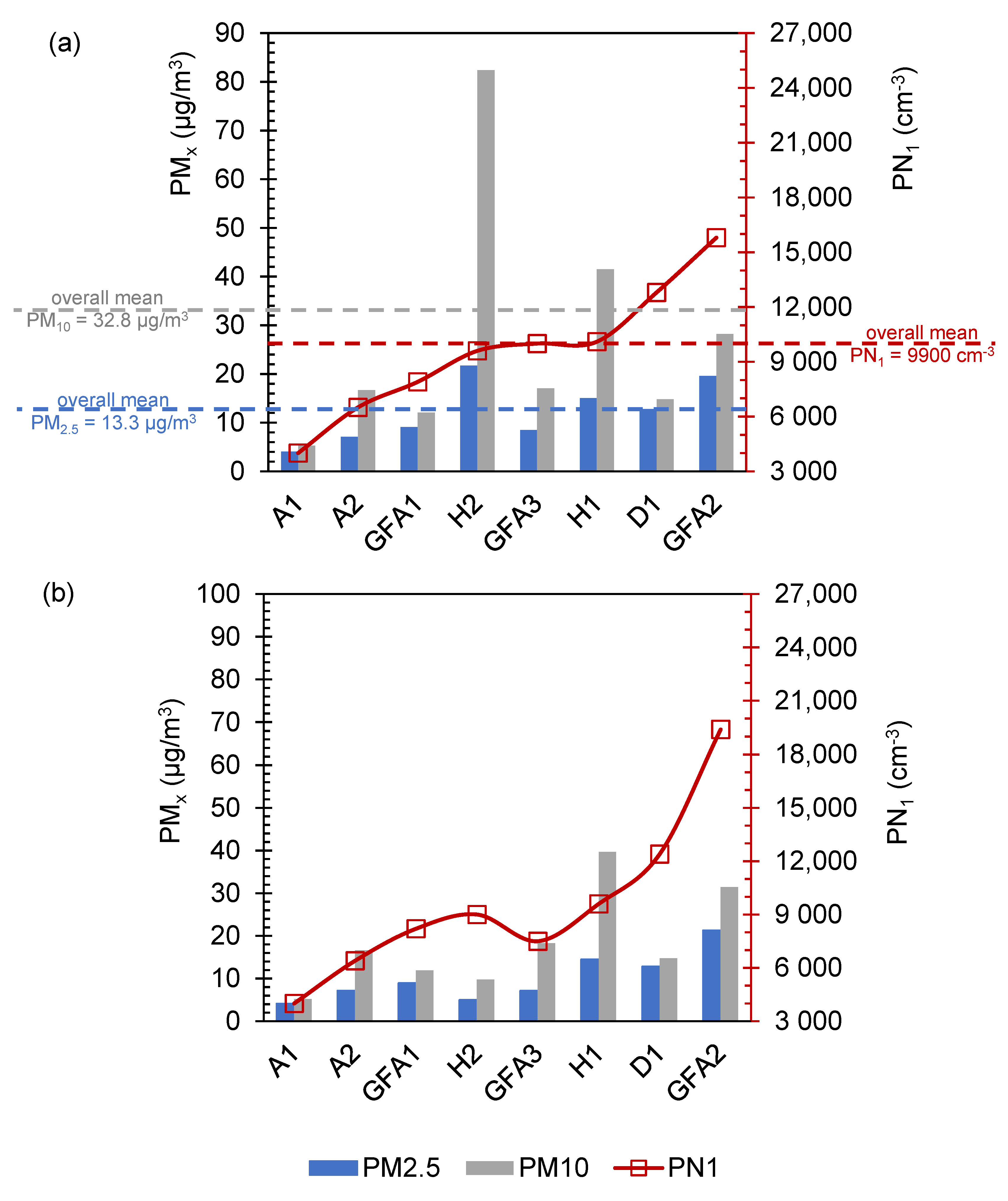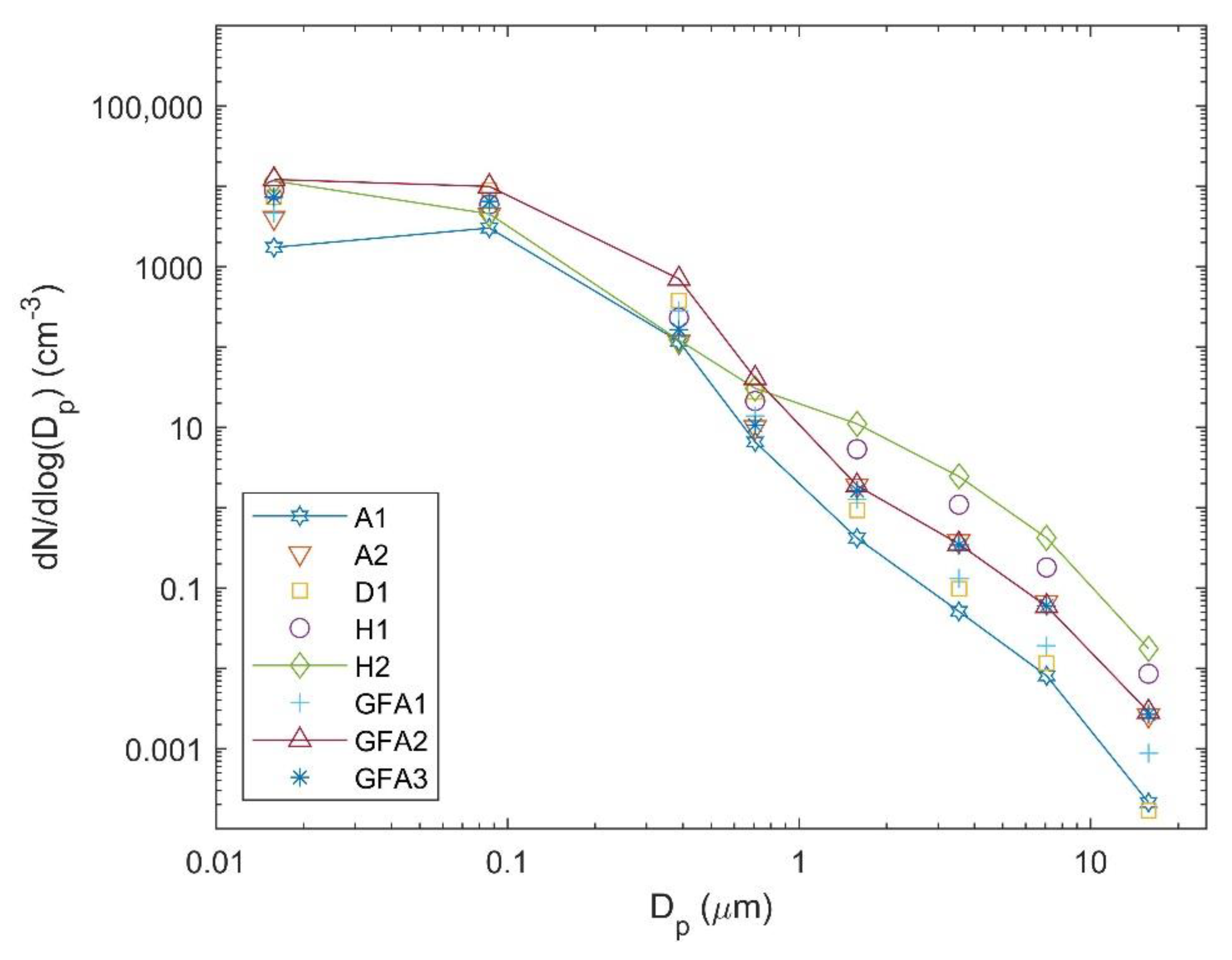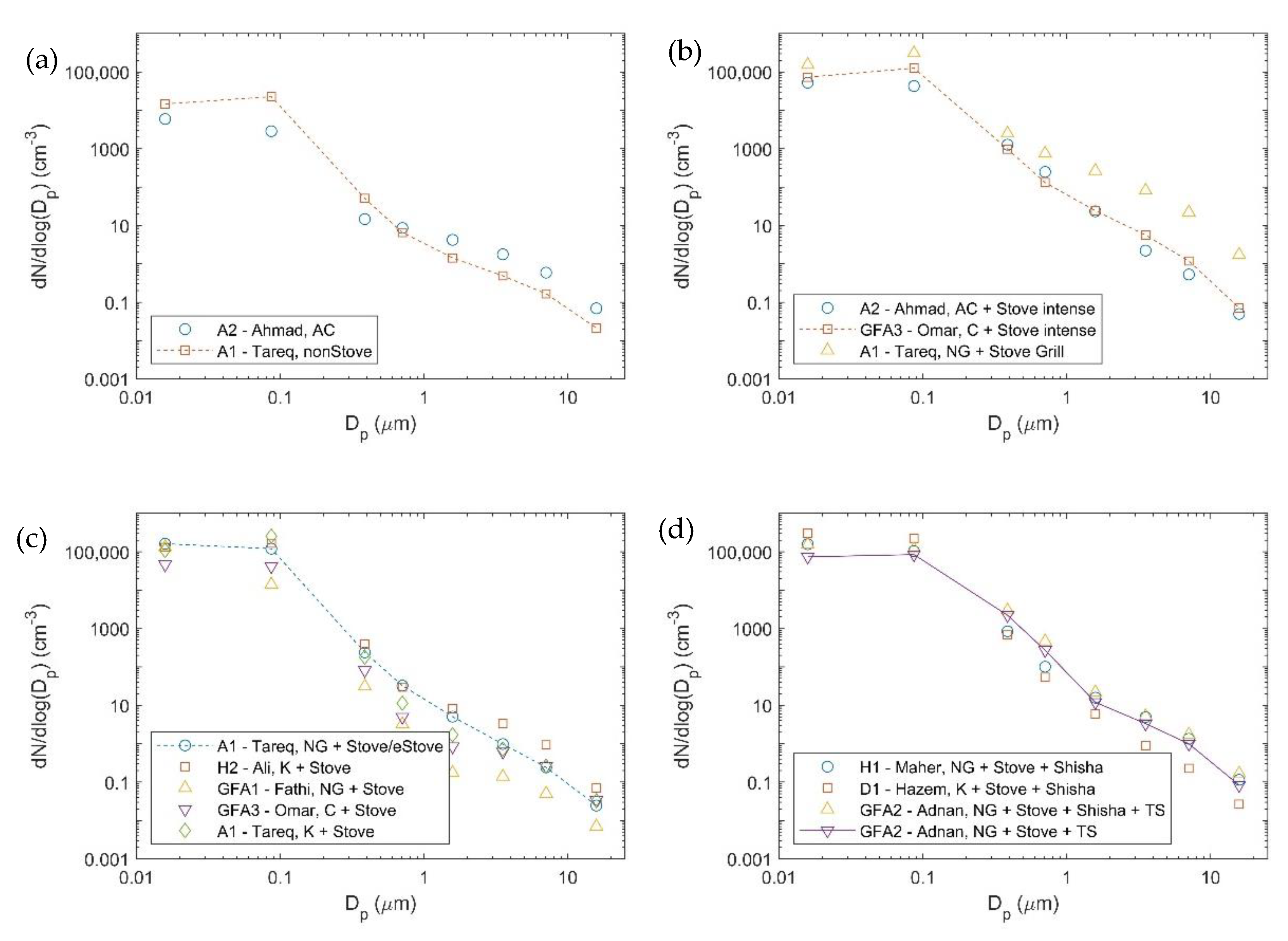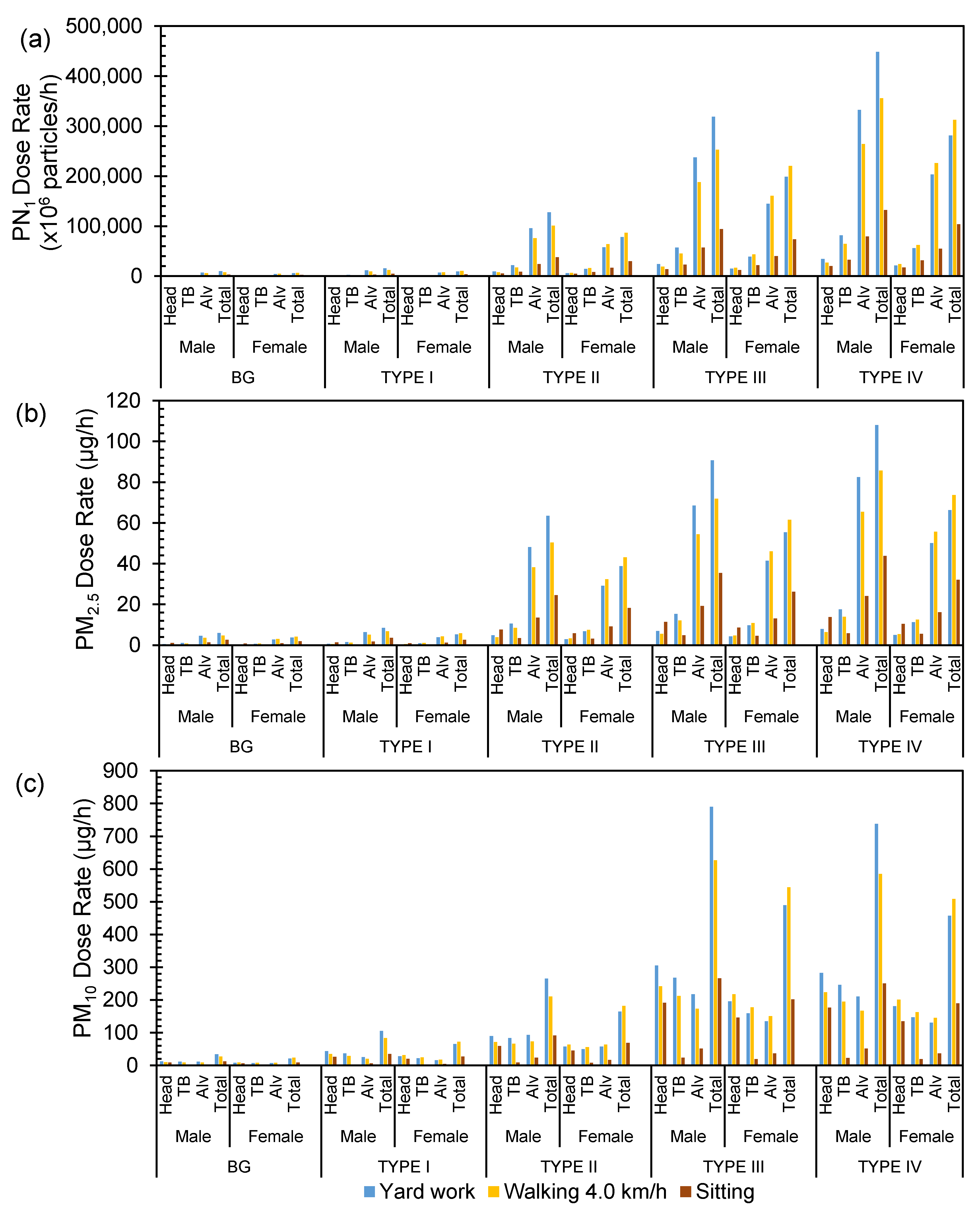Regional Inhaled Deposited Dose of Indoor Combustion-Generated Aerosols in Jordanian Urban Homes
Abstract
1. Introduction
2. Methodology
2.1. Inhaled Deposited Dose Rate of Indoor Combustion-Generated Aerosols
2.2. Indoor Aerosol Concentrations and Size Distributions in Jordanian Urban Homes
3. Results and Discussion
3.1. Overview of Indoor Exposure to Combustion-Generated Aerosols in Jordanian Urban Homes
3.1.1. Indoor Aerosol Concentrations during Background Periods
3.1.2. Indoor Activity Categories for Inhaled Deposited Dose Analysis
- TYPE I: Non-combustion cooking activities (i.e., microwave, water heater jug).
- TYPE II: Intensive cooking activities by combustion (i.e., natural gas stove) combined with non-combustion heating (central or AC).
- TYPE III: Cooking activities by combustion (i.e., natural gas stove) combined with combustion heating (kerosene or natural gas).
- TYPE IV: Cooking activities by combustion (i.e., natural gas stove) combined with combustion heating (kerosene or natural gas) and smoking (shisha and/or tobacco).
3.2. Inhaled Deposited Dose Scenarios
- Housework activities: effort equivalent to yardwork.
- Moving activities: effort corresponding to running at 8 km/h and walking at 4 km/h.
- Resting activities: standing and sitting.
3.2.1. Regional Inhaled Deposited Dose Rates for Background Condition Scenarios
3.2.2. Regional Inhaled Deposited Dose Rates for TYPE I Scenarios
3.2.3. Regional Inhaled Deposited Dose Rates for Combustion Scenarios (TYPEs II, II, IV)
3.3. Regional Inhaled Deposited Dose Rates Based on Median Particle Number Size Distributions
4. Conclusions
Supplementary Materials
Author Contributions
Funding
Acknowledgments
Conflicts of Interest
References
- World Health Organization (WHO). Household Air Pollution and Health. 2018. Available online: https://www.who.int/news-room/fact-sheets/detail/household-air-pollution-and-health (accessed on 28 September 2020).
- World Health Organization (WHO). The Right to Healthy Indoor Air. 2000. Available online: http://www.euro.who.int/en/health-topics/environment-and-health/air-quality/publications/pre2009/the-right-to-healthy-indoor-air (accessed on 3 December 2019).
- Klepeis, N.E.; Nelson, W.C.; Ott, W.R.; Robinson, J.P.; Tsang, A.M.; Switzer, P.; Behar, J.V.; Hern, S.C.; Engelmann, W.H. The National Human Activity Pattern Survey (NHAPS): A resource for assessing exposure to environmental pollutants. J. Expo. Sci. Environ. Epidemiol. 2001, 11, 231–252. [Google Scholar] [CrossRef] [PubMed]
- Jones, A. Chapter 3. Indoor air quality and health. Alberta Oil Sands 2002, 33, 57–115. [Google Scholar] [CrossRef]
- Abadie, M.O.; Blondeau, P. PANDORA database: A compilation of indoor air pollutant emissions. HVAC R Res. 2011, 17, 602–613. [Google Scholar]
- Chen, C.; Zhao, B. Review of relationship between indoor and outdoor particles: I/O ratio, infiltration factor and penetration factor. Atmos. Environ. 2011, 45, 275–288. [Google Scholar] [CrossRef]
- Hussein, T.; Wierzbicka, A.; Löndahl, J.; Lazaridis, M.; Hänninen, O. Indoor aerosol modeling for assessment of exposure and respiratory tract deposited dose. Atmos. Environ. 2015, 106, 402–411. [Google Scholar] [CrossRef]
- Morawska, L.; He, C.; Johnson, G.; Jayaratne, R.; Salthammer, T.; Wang, H.; Uhde, E.; Bostrom, T.; Modini, R.; Ayoko, G.; et al. An investigation into the characteristics and formation mechanisms of particles originating from the operation of laser printers. Environ. Sci. Technol. 2009, 43, 1015–1022. [Google Scholar] [CrossRef]
- Sangiorgi, G.; Ferrero, L.; Ferrini, B.; Porto, C.L.; Perrone, M.; Zangrando, R.; Gambaro, A.; Lazzati, Z.; Bolzacchini, E. Indoor airborne particle sources and semi-volatile partitioning effect of outdoor fine PM in offices. Atmos. Environ. 2013, 65, 205–214. [Google Scholar] [CrossRef]
- He, C.; Morawska, L.; Hitchins, J.; Gilbert, D. Contribution from indoor sources to particle number and mass concentrations in residential houses. Atmos. Environ. 2004, 38, 3405–3415. [Google Scholar] [CrossRef]
- Afshari, A.; Matson, U.; Ekberg, L.E. Characterization of indoor sources of fine and ultrafine particles: A study conducted in a full-scale chamber. Indoor Air 2005, 15, 141–150. [Google Scholar] [CrossRef]
- Ferron, G.; Gebhart, J. Estimation of the lung deposition of aerosol particles produced with medical nebulizers. J. Aerosol Sci. 1988, 19, 1083–1086. [Google Scholar] [CrossRef]
- ICRP. Annals of the International Commission on Radiological Protection ICRP Publication 66: Human Respiratory Tract Model. for Radiological Protection; International Commission on Radiological Protection: Ottawa, ON, Canada, 1994. [Google Scholar]
- Anjilvel, S.; Asgharian, B. A multiple-path model of particle deposition in the rat lung. Fundam. Appl. Toxicol. 1995, 28, 41–50. [Google Scholar] [CrossRef]
- Madanat, H.; Barnes, M.D.; Cole, E.C. Knowledge of the effects of indoor air quality on health among women in Jordan. Heal. Educ. Behav. 2006, 35, 105–118. [Google Scholar] [CrossRef] [PubMed]
- Hussein, T. Particle size distributions inside a university office in Amman, Jordan. Jordan J. Phys. 2014, 7, 73–83. [Google Scholar]
- Hussein, T.; Dada, L.; Juwhari, H.; Faouri, D. Characterization, fate, and re-suspension of aerosol particles (0.3–10 µm): The effects of occupancy and carpet use. Aerosol Air Qual. Res. 2015, 15, 2367–2377. [Google Scholar] [CrossRef]
- Hussein, T. Indoor-to-outdoor relationship of aerosol particles inside a naturally ventilated apartment-A comparison between single-parameter analysis and indoor aerosol model simulation. Sci. Total. Environ. 2017, 321–330. [Google Scholar] [CrossRef] [PubMed]
- Hussein, T.; Löndahl, J.; Paasonen, P.; Koivisto, A.J.; Petäjä, T.; Hämeri, K.; Kulmala, M. Modeling regional deposited dose of submicron aerosol particles. Sci. Total. Environ. 2013, 458, 140–149. [Google Scholar] [CrossRef] [PubMed]
- Hussein, T.; Saleh, S.S.A.; Dos Santos, V.N.; Boor, B.E.; Koivisto, A.J.; Löndahl, J. Regional inhaled deposited dose of urban aerosols in an Eastern Mediterranean city. Atmosphere 2019, 10, 530. [Google Scholar] [CrossRef]
- Holmes, J.R. How much air do we breath? California Environmental Protection Agency: Sacramento, CA, USA, 1994; Research note 94–11.
- Löndahl, J.; Massling, A.; Pagels, J.; Swietlicki, E.; Vaclavik, E.; Loft, S. Size-resolved respiratory-tract deposition of fine and ultrafine hydrophobic and hygroscopic aerosol particles during rest and exercise. Inhal. Toxicol. 2007, 19, 109–116. [Google Scholar] [CrossRef]
- Hussein, T.; Alameer, A.; Jaghbeir, O.; Albeitshaweesh, K.; Malkawi, M.; Boor, B.E.; Koivisto, A.J.; Löndahl, J.; Alrifai, O.; Al-Hunaiti, A. Indoor particle concentrations, size distributions, and exposures in middle eastern microenvironments. Atmosphere 2019, 11, 41. [Google Scholar] [CrossRef]
- Wang, Y.; Xing, Z.; Zhao, S.; Zheng, M.; Mu, C.; Du, K. Are emissions of black carbon from gasoline vehicles overestimated? Real-time, in situ measurement of black carbon emission factors. Sci. Total. Environ. 2016, 547, 422–428. [Google Scholar] [CrossRef]
- Jiang, R.; Acevedo-Bolton, V.; Cheng, K.-C.; Klepeis, N.E.; Ott, W.; Hildemann, L.M. Determination of response of real-time SidePak AM510 monitor to secondhand smoke, other common indoor aerosols, and outdoor aerosol. J. Environ. Monit. 2011, 13, 1695–1702. [Google Scholar] [CrossRef] [PubMed]
- Matson, U.; Ekberg, L.E.; Afshari, A. Measurement of ultrafine particles: A comparison of two handheld condensation particle counters. Aerosol Sci. Technol. 2004, 38, 487–495. [Google Scholar] [CrossRef]
- Hussein, T.; Boor, B.E.; Dos Santos, V.N.; Kangasluoma, J.; Petäjä, T.; Lihavainen, H. Mobile aerosol measurement in the Eastern Mediterranean-A utilization of portable instruments. Aerosol Air Qual. Res. 2017, 17, 1875–1886. [Google Scholar] [CrossRef]
- Hussein, T.; Saleh, S.S.A.; Dos Santos, V.N.; Abdullah, H.; Boor, B.E. Black carbon and particulate matter concentrations in Eastern Mediterranean urban conditions: An assessment based on integrated stationary and mobile observations. Atmosphere 2019, 10, 323. [Google Scholar] [CrossRef]
- Maricq, M.M. Monitoring motor vehicle PM emissions: An evaluation of three portable low-cost aerosol instruments. Aerosol Sci. Technol. 2013, 47, 564–573. [Google Scholar] [CrossRef]
- Chen, L.-W.A.; Chancellor, G.; Evenstad, J.; Farnsworth, J.E.; Hase, A.; Olson, G.M.; Sreenath, A.; Agarwal, J.K. A novel optical instrument for estimating size segregated aerosol mass concentration in real time. Aerosol Sci. Technol. 2009, 43, 939–950. [Google Scholar] [CrossRef]
- Viana, M.; Rivas, I.; Reche, C.; Fonseca, A.S.; Pérez, N.; Querol, X.; Alastuey, A.; Álvarez-Pedrerol, M.; Sunyer, J. Field comparison of portable and stationary instruments for outdoor urban air exposure assessments. Atmos. Environ. 2015, 123, 220–228. [Google Scholar] [CrossRef]
- Wu, T.; Boor, B.E. Urban aerosol size distributions: A global perspective. Atmos Chem Phys. Discuss. 2020, 2020, 1–83. [Google Scholar] [CrossRef]






| Home ID | PN (cm−3) | |||
|---|---|---|---|---|
| Mean ± SD | 25% | Median | 75% | |
| A1 | 4000 ± 300 | 3800 | 4000 | 4200 |
| A2 | 6500 ± 900 | 5700 | 6400 | 7100 |
| D1 | 12,800 ± 1300 | 12,000 | 12,400 | 13,400 |
| H1 | 10,100 ± 1400 | 9100 | 9600 | 11,300 |
| H2 | 9600 ± 2300 | 7600 | 9000 | 11,800 |
| GFA1 | 7900 ± 2900 | 4800 | 8200 | 10,800 |
| GFA2 | 15,800 ± 5800 | 10,000 | 19,400 | 20,800 |
| GFA3 | 10,000 ± 3800 | 6800 | 7500 | 14,100 |
| Home ID | PM2.5 (µg/m3) | PM10 (µg/m3) | ||||||
|---|---|---|---|---|---|---|---|---|
| Mean ± SD | 25% | Median | 75% | Mean ± SD | 25% | Median | 75% | |
| A1 | 4.1 ± 0.1 | 4.0 | 4.1 | 4.2 | 5.3 ± 0.5 | 5.0 | 5.2 | 5.6 |
| A2 | 7.1 ± 0.4 | 6.8 | 7.1 | 7.4 | 16.7 ± 1.5 | 15.5 | 16.6 | 17.9 |
| D1 | 12.8 ± 0.7 | 12.3 | 12.8 | 13.4 | 14.8 ± 1.2 | 13.9 | 14.8 | 15.6 |
| H1 | 15.0 ± 2.6 | 12.7 | 14.5 | 17.8 | 41.5 ± 6.7 | 36.1 | 39.7 | 47.1 |
| H2 | 21.7 ± 21.2 | 4.4 | 4.9 | 46.7 | 82.4 ± 90.8 | 7.6 | 9.7 | 190.5 |
| GFA1 | 9.1 ± 1.1 | 8.1 | 8.9 | 10.2 | 12.0 ± 1.6 | 10.8 | 11.9 | 13.6 |
| GFA2 | 19.6 ± 4.4 | 15.5 | 21.3 | 22.9 | 28.2 ± 8.0 | 20.5 | 31.4 | 34.9 |
| GFA3 | 8.5 ± 3.5 | 5.3 | 7.1 | 12.2 | 17.1 ± 7.8 | 8.9 | 18.3 | 24.4 |
| Mean | SD | 25% | Median | 75% | ||
|---|---|---|---|---|---|---|
| PN1 (cm−3) | Background | 9900 | 4900 | 6700 | 8800 | 12,900 |
| TYPE I | 16,400 | 17,100 | 7900 | 1,2000 | 16,600 | |
| TYPE II | 144,500 | 97,500 | 71,700 | 112,200 | 192,700 | |
| TYPE III | 289,200 | 189,800 | 151,700 | 281,700 | 390,600 | |
| TYPE IV | 371,300 | 232,300 | 184,600 | 318,700 | 532,700 | |
| PM2.5 (µg/m3) | Background | 13.3 | 14.8 | 5.4 | 7.9 | 14.1 |
| TYPE I | 16.0 | 10.7 | 10.3 | 12.9 | 20.0 | |
| TYPE II | 120.5 | 66.6 | 72.5 | 100.0 | 148.5 | |
| TYPE III | 169.9 | 134.5 | 80.5 | 139.0 | 220.8 | |
| TYPE IV | 267.2 | 237.6 | 94.4 | 174.5 | 409.8 | |
| PM10 (µg/m3) | Background | 32.8 | 53.3 | 8.0 | 12.9 | 26.8 |
| TYPE I | 81.7 | 52.8 | 43.8 | 68.4 | 116.4 | |
| TYPE II | 259.5 | 123.6 | 171.2 | 246.7 | 320.3 | |
| TYPE III | 650.6 | 714.5 | 203.2 | 400.8 | 758.5 | |
| TYPE IV | 697.7 | 596.5 | 207.7 | 575.0 | 1011.7 |
| Scenario | Adult Male | Adult Female | |||||||
|---|---|---|---|---|---|---|---|---|---|
| Head | TB | Alv | Total | Head | TB | Alv | Total | ||
| PN1 (×106 #/h) | Yardwork | 700 | 1700 | 7300 | 9700 | 500 | 1200 | 4400 | 6000 |
| Running 8.0 km/h | 1500 | 3400 | 14,500 | 19,400 | 1300 | 3200 | 12,300 | 16,800 | |
| Walking 4.0 km/h | 600 | 1400 | 5800 | 7700 | 500 | 1300 | 4900 | 6700 | |
| Standing | 500 | 800 | 2200 | 3500 | 400 | 700 | 1400 | 2600 | |
| Sitting | 400 | 700 | 1800 | 2900 | 400 | 700 | 1200 | 2300 | |
| PM2.5(µg/h) | Yardwork | 0.5 | 1.0 | 4.5 | 5.9 | 0.3 | 0.6 | 2.7 | 3.7 |
| Running 8.0 km/h | 0.9 | 2.0 | 9.0 | 11.9 | 0.8 | 1.8 | 7.7 | 10.3 | |
| Walking 4.0 km/h | 0.4 | 0.8 | 3.6 | 4.7 | 0.3 | 0.7 | 3.1 | 4.1 | |
| Standing | 1.2 | 0.4 | 1.6 | 3.2 | 0.8 | 0.3 | 1.0 | 2.2 | |
| Sitting | 1.0 | 0.3 | 1.3 | 2.6 | 0.7 | 0.3 | 0.9 | 1.9 | |
| PM10 (µg/h) | Yardwork | 11.8 | 11.0 | 11.2 | 34.0 | 7.6 | 6.6 | 7.0 | 21.1 |
| Running 8.0 km/h | 23.5 | 22.0 | 22.4 | 68.0 | 21.2 | 18.5 | 19.5 | 59.2 | |
| Walking 4.0 km/h | 9.3 | 8.7 | 8.9 | 27.0 | 8.4 | 7.3 | 7.7 | 23.4 | |
| Standing | 10.0 | 1.3 | 3.3 | 14.6 | 7.1 | 1.0 | 2.2 | 10.3 | |
| Sitting | 8.2 | 1.0 | 2.7 | 12.0 | 6.2 | 0.9 | 1.9 | 9.0 | |
| Scenario | Adult Male | Adult Female | |||||||
|---|---|---|---|---|---|---|---|---|---|
| Head | TB | Alv | Total | Head | TB | Alv | Total | ||
| PN1 (×106 #/h) | Yardwork | 1200 | 2700 | 11,700 | 15,600 | 700 | 1800 | 7000 | 9600 |
| Running 8.0 km/h | 2400 | 5400 | 23,300 | 31,100 | 2000 | 5100 | 19,700 | 26,900 | |
| Walking 4.0 km/h | 900 | 2200 | 9200 | 12,300 | 800 | 2000 | 7800 | 10,600 | |
| Standing | 800 | 1300 | 3500 | 5600 | 700 | 1200 | 2300 | 4100 | |
| Sitting | 700 | 1100 | 2900 | 4600 | 600 | 1000 | 2000 | 3600 | |
| PM2.5 (µg/h) | Yardwork | 0.6 | 1.4 | 6.4 | 8.5 | 0.4 | 0.9 | 3.9 | 5.2 |
| Running 8.0 km/h | 1.3 | 2.9 | 12.7 | 16.9 | 1.1 | 2.6 | 10.9 | 14.6 | |
| Walking 4.0 km/h | 0.5 | 1.1 | 5.1 | 6.7 | 0.5 | 1.0 | 4.3 | 5.8 | |
| Standing | 1.6 | 0.5 | 2.2 | 4.3 | 1.1 | 0.4 | 1.4 | 3.0 | |
| Sitting | 1.3 | 0.4 | 1.8 | 3.5 | 1.0 | 0.4 | 1.2 | 2.6 | |
| PM10 (µg/h) | Yardwork | 43.5 | 36.5 | 25.1 | 105.0 | 27.9 | 21.7 | 15.6 | 65.2 |
| Running 8.0 km/h | 86.9 | 73.0 | 50.1 | 210.0 | 78.1 | 60.9 | 43.8 | 182.8 | |
| Walking 4.0 km/h | 34.5 | 29.0 | 19.9 | 83.3 | 30.9 | 24.1 | 17.3 | 72.4 | |
| Standing | 32.1 | 3.6 | 7.2 | 42.9 | 22.9 | 2.7 | 4.8 | 30.4 | |
| Sitting | 26.3 | 2.9 | 5.9 | 35.1 | 20.0 | 2.4 | 4.2 | 26.6 | |
| Scenario | Adult Male | Adult Female | |||||||
|---|---|---|---|---|---|---|---|---|---|
| Head | TB | Alv | Total | Head | TB | Alv | Total | ||
| PN1 (×106 #/h) | Yardwork | 9600 | 21,900 | 95,900 | 127,500 | 5900 | 14,600 | 57,500 | 78,000 |
| Running 8.0 km/h | 19,300 | 43,900 | 191,800 | 255,000 | 16,400 | 41,100 | 161,400 | 218,900 | |
| Walking 4.0 km/h | 7600 | 17,400 | 76,100 | 101,100 | 6500 | 16,300 | 63,900 | 86,700 | |
| Standing | 6500 | 10,500 | 29,400 | 46,400 | 5200 | 9500 | 19,100 | 33,800 | |
| Sitting | 5300 | 8600 | 24,100 | 38,000 | 4600 | 8300 | 16,700 | 29,600 | |
| PM2.5 (µg/h) | Yardwork | 4.8 | 10.6 | 48.1 | 63.5 | 2.9 | 6.8 | 29.0 | 38.7 |
| Running 8.0 km/h | 9.5 | 21.1 | 96.2 | 126.9 | 8.2 | 19.0 | 81.5 | 108.7 | |
| Walking 4.0 km/h | 3.8 | 8.4 | 38.2 | 50.3 | 3.3 | 7.5 | 32.3 | 43.0 | |
| Standing | 9.3 | 4.1 | 16.5 | 30.0 | 6.6 | 3.7 | 10.5 | 20.8 | |
| Sitting | 7.6 | 3.4 | 13.5 | 24.5 | 5.8 | 3.2 | 9.2 | 18.2 | |
| PM10 (µg/h) | Yardwork | 89.3 | 83.0 | 92.5 | 264.8 | 57.2 | 49.7 | 56.9 | 163.8 |
| Running 8.0 km/h | 178.7 | 166.0 | 185.0 | 529.7 | 160.5 | 139.5 | 159.6 | 459.6 | |
| Walking 4.0 km/h | 70.9 | 65.8 | 73.4 | 210.0 | 63.6 | 55.3 | 63.2 | 182.0 | |
| Standing | 72.6 | 10.7 | 28.1 | 111.4 | 51.7 | 8.6 | 18.4 | 78.6 | |
| Sitting | 59.4 | 8.7 | 23.0 | 91.2 | 45.3 | 7.5 | 16.1 | 68.8 | |
| Scenario | Adult Male | Adult Female | |||||||
|---|---|---|---|---|---|---|---|---|---|
| Head | TB | Alv | Total | Head | TB | Alv | Total | ||
| PN1 (×106 #/h) | Yardwork | 24,300 | 57,200 | 237,200 | 318,700 | 15,100 | 38,900 | 144,500 | 198,600 |
| Running 8.0 km/h | 48,700 | 114,300 | 474,500 | 637,500 | 42,500 | 109,200 | 405,400 | 557,100 | |
| Walking 4.0 km/h | 19,300 | 45,300 | 188,200 | 252,800 | 16,800 | 43,200 | 160,600 | 220,600 | |
| Standing | 17,100 | 28,000 | 70,000 | 115,000 | 13,800 | 25,000 | 45,500 | 84,300 | |
| Sitting | 14,000 | 22,900 | 57,200 | 94,100 | 12,100 | 21,800 | 39,800 | 73,700 | |
| PM2.5 (µg/h) | Yardwork | 6.9 | 15.2 | 68.5 | 90.6 | 4.2 | 9.7 | 41.4 | 55.4 |
| Running 8.0 km/h | 13.8 | 30.5 | 137.0 | 181.3 | 11.9 | 27.3 | 116.2 | 155.4 | |
| Walking 4.0 km/h | 5.5 | 12.1 | 54.3 | 71.9 | 4.7 | 10.8 | 46.0 | 61.5 | |
| Standing | 13.8 | 5.9 | 23.5 | 43.2 | 9.8 | 5.2 | 14.9 | 29.9 | |
| Sitting | 11.3 | 4.8 | 19.2 | 35.3 | 8.6 | 4.5 | 13.0 | 26.1 | |
| PM10 (µg/h) | Yardwork | 304.8 | 267.3 | 217.7 | 789.8 | 195.4 | 159.3 | 135.0 | 489.6 |
| Running 8.0 km/h | 609.6 | 534.6 | 435.3 | 1579.5 | 548.2 | 446.8 | 378.7 | 1373.7 | |
| Walking 4.0 km/h | 241.7 | 212.0 | 172.6 | 626.4 | 217.1 | 177.0 | 150.0 | 544.0 | |
| Standing | 233.9 | 28.5 | 62.6 | 325.0 | 166.7 | 22.1 | 41.5 | 230.2 | |
| Sitting | 191.4 | 23.3 | 51.2 | 265.9 | 145.8 | 19.3 | 36.3 | 201.5 | |
| Scenario | Adult Male | Adult Female | |||||||
|---|---|---|---|---|---|---|---|---|---|
| Head | TB | Alv | Total | Head | TB | Alv | Total | ||
| PN1 (×106 #/h) | Yardwork | 34,300 | 81,600 | 332,400 | 448,300 | 21,500 | 55,900 | 203,600 | 281,100 |
| Running 8.0 km/h | 68,700 | 163,100 | 664,900 | 896,700 | 60,400 | 156,900 | 571,200 | 788,600 | |
| Walking 4.0 km/h | 27,200 | 64,700 | 263,700 | 355,600 | 23,900 | 62,100 | 226,200 | 312,300 | |
| Standing | 24,500 | 40,200 | 96,600 | 161,300 | 19,800 | 35,700 | 62,800 | 118,400 | |
| Sitting | 20,100 | 32,900 | 79,100 | 132,000 | 17,400 | 31,300 | 55,000 | 103,600 | |
| PM2.5 (µg/h) | Yardwork | 8.0 | 17.6 | 82.4 | 108.0 | 4.9 | 11.3 | 50.1 | 66.3 |
| Running 8.0 km/h | 15.9 | 35.2 | 164.9 | 216.0 | 13.8 | 31.7 | 140.5 | 185.9 | |
| Walking 4.0 km/h | 6.3 | 13.9 | 65.4 | 85.6 | 5.4 | 12.6 | 55.6 | 73.6 | |
| Standing | 16.9 | 7.2 | 29.4 | 53.5 | 11.8 | 6.3 | 18.5 | 36.6 | |
| Sitting | 13.8 | 5.9 | 24.1 | 43.8 | 10.4 | 5.5 | 16.2 | 32.0 | |
| PM10 (µg/h) | Yardwork | 282.0 | 245.5 | 210.3 | 737.8 | 180.7 | 146.5 | 130.3 | 457.4 |
| Running 8.0 km/h | 564.0 | 491.1 | 420.6 | 1475.7 | 507.0 | 410.9 | 365.5 | 1283.4 | |
| Walking 4.0 km/h | 223.7 | 194.7 | 166.8 | 585.2 | 200.8 | 162.7 | 144.8 | 508.3 | |
| Standing | 215.6 | 27.4 | 63.1 | 306.1 | 153.6 | 21.4 | 41.5 | 216.4 | |
| Sitting | 176.4 | 22.4 | 51.6 | 250.5 | 134.4 | 18.7 | 36.3 | 189.4 | |
Publisher’s Note: MDPI stays neutral with regard to jurisdictional claims in published maps and institutional affiliations. |
© 2020 by the authors. Licensee MDPI, Basel, Switzerland. This article is an open access article distributed under the terms and conditions of the Creative Commons Attribution (CC BY) license (http://creativecommons.org/licenses/by/4.0/).
Share and Cite
Hussein, T.; Boor, B.E.; Löndahl, J. Regional Inhaled Deposited Dose of Indoor Combustion-Generated Aerosols in Jordanian Urban Homes. Atmosphere 2020, 11, 1150. https://doi.org/10.3390/atmos11111150
Hussein T, Boor BE, Löndahl J. Regional Inhaled Deposited Dose of Indoor Combustion-Generated Aerosols in Jordanian Urban Homes. Atmosphere. 2020; 11(11):1150. https://doi.org/10.3390/atmos11111150
Chicago/Turabian StyleHussein, Tareq, Brandon E. Boor, and Jakob Löndahl. 2020. "Regional Inhaled Deposited Dose of Indoor Combustion-Generated Aerosols in Jordanian Urban Homes" Atmosphere 11, no. 11: 1150. https://doi.org/10.3390/atmos11111150
APA StyleHussein, T., Boor, B. E., & Löndahl, J. (2020). Regional Inhaled Deposited Dose of Indoor Combustion-Generated Aerosols in Jordanian Urban Homes. Atmosphere, 11(11), 1150. https://doi.org/10.3390/atmos11111150





